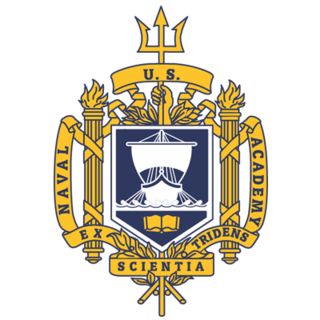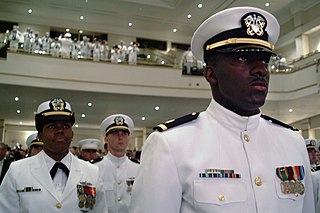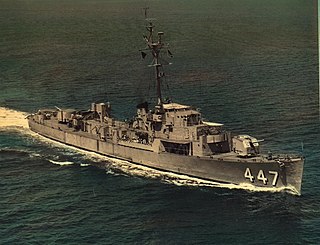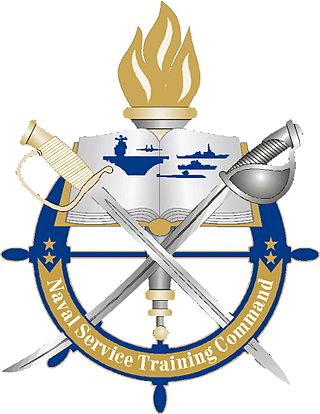
The United States Naval Academy is a federal service academy in Annapolis, Maryland. It was established on 10 October 1845 during the tenure of George Bancroft as Secretary of the Navy. The Naval Academy is the second oldest of the five U.S. service academies and it educates midshipmen for service in the officer corps of the United States Navy and United States Marine Corps. It is part of the Naval University System. The 338-acre (137 ha) campus is located on the former grounds of Fort Severn at the confluence of the Severn River and Chesapeake Bay in Anne Arundel County, 33 miles (53 km) east of Washington, D.C., and 26 miles (42 km) southeast of Baltimore. The entire campus, known colloquially as the Yard, is a National Historic Landmark and home to many historic sites, buildings, and monuments. It replaced Philadelphia Naval Asylum in Philadelphia that had served as the first United States Naval Academy from 1838 to 1845 when the Naval Academy formed in Annapolis.
A midshipman is an officer of the lowest rank in the Royal Navy, United States Navy, and many Commonwealth navies. Commonwealth countries which use the rank include Canada, Australia, Bangladesh, Namibia, New Zealand, South Africa, India, Pakistan, Singapore, Sri Lanka, and Kenya.

The United States Merchant Marine is an organization composed of United States civilian mariners and U.S. civilian and federally owned merchant vessels. Both the civilian mariners and the merchant vessels are managed by a combination of the government and private sectors, and engage in commerce or transportation of goods and services in and out of the navigable waters of the United States. The Merchant Marine primarily transports domestic and international cargo and passengers during peacetime, and operate and maintain deep-sea merchant ships, tugboats, towboats, ferries, dredges, excursion vessels, charter boats and other waterborne craft on the oceans, the Great Lakes, rivers, canals, harbors, and other waterways. In times of war, the Merchant Marine can be an auxiliary to the United States Navy, and can be called upon to deliver military personnel and materiel for the military.

The V-12 Navy College Training Program was designed to supplement the force of commissioned officers in the United States Navy during World War II. Between July 1, 1943, and June 30, 1946, more than 125,000 participants were enrolled in 131 colleges and universities in the United States. Numerous participants attended classes and lectures at their respective colleges and earned completion degrees for their studies. Some even returned from their naval obligations to earn a degree from the colleges where they were previously stationed.
The United States service academies, also known as United States military academies, are federal academies for the undergraduate education and training of commissioned officers for the United States Armed Forces.

The United States Merchant Marine Academy is a United States service academy in Kings Point, New York. It trains its midshipmen to serve as officers in the United States Merchant Marine, branches of the United States Armed Forces and the transportation industry. Midshipmen are trained in different fields such as marine engineering, navigation, ship's administration, maritime law, personnel management, international law, customs, and many other subjects important to the task of running a large ship.
Officer Cadet is a rank held by military cadets during their training to become commissioned officers. In the United Kingdom, the rank is also used by members of University Royal Naval Units, University Officer Training Corps and University Air Squadron; however, these are not trainee officers with many not choosing a career in the armed forces.

United States Naval Reserve (Women's Reserve), better known as the WAVES (for Women Accepted for Volunteer Emergency Service), was the women's branch of the United States Naval Reserve during World War II. It was established on July 21, 1942, by the U.S. Congress and signed into law by President Franklin D. Roosevelt on July 30. This authorized the U.S. Navy to accept women into the Naval Reserve as commissioned officers and at the enlisted level, effective for the duration of the war plus six months. The purpose of the law was to release officers and men for sea duty and replace them with women in shore establishments. Mildred H. McAfee, on leave as president of Wellesley College, became the first director of the WAVES. She was commissioned a lieutenant commander on August 3, 1942, and later promoted to commander and then to captain.

The Naval Reserve Officer Training Corps (NROTC) program is a college-based, commissioned officer training program of the United States Navy and the United States Marine Corps.

The United States Marine Corps Officer Candidates School (OCS) is a training regiment designed to screen and evaluate potential Marine Corps Officers. Those who successfully complete the period of instruction are commissioned as Second Lieutenants in the United States Marines. Unlike the other United States military services, the majority of Marine Corps officers complete OCS to earn a commission; the exceptions are midshipmen from the United States Naval Academy, limited duty officers and warrant officers, and inter-service transfers. It is located at Marine Corps Base Quantico.

Robert Carlisle Giffen was an admiral in the United States Navy.

The United States Navy's Officer Candidate School provides initial training for officers of the line and select operational staff corps communities in the United States Navy. Along with United States Naval Academy (USNA) and Naval Reserve Officer Training Corps (NROTC), OCS is one of three principal sources of newly commissioned naval officers.

Badin Hall is one of the 32 Residence Halls on the campus of the University of Notre Dame and one of the 14 female dorms. The smallest residence hall on campus, it is located on South Quad, between Howard Hall and the Coleman-Morse center. It was built in 1897 and hosted the Manual Labor School until 1917 before being converted into a men's dorm. During World War II, it was part of the United States Naval Reserve Midshipmen's School, and in 1972 it became one of the first two residence halls at Notre Dame to host women.
Fred "Buzz" Borries was an American college football player who played halfback for the Navy Midshipmen football team of the U.S. Naval Academy from 1932 to 1934.

USS Albert T. Harris (DE-447) was a John C. Butler-class destroyer escort acquired by the U.S. Navy during World War II. The primary purpose of the destroyer escort was to escort and protect ships in convoy, in addition to other tasks as assigned, such as patrol or radar picket. Post-war she returned home with two battle stars to her credit.

James Lemuel Holloway Jr. was a four-star admiral in the United States Navy who served as superintendent of the United States Naval Academy from 1947–1950; as Chief of Naval Personnel from 1953 to 1957; and as commander in chief of all United States naval forces in the eastern Atlantic and Mediterranean from 1957 to 1959, in which capacity he commanded the 1958 American intervention in Lebanon. As founder of the Holloway Plan, he was responsible for creating the modern Naval Reserve Officer Training Corps.
The US Navy had four programs for the training of naval aviators.

Stuart Howe Ingersoll was a vice admiral of the United States Navy. He was a naval aviator whose career included service as an aircraft carrier commander during World War II and tours as commander-in-chief of the United States Seventh Fleet, President of the Naval War College, and Commandant of Midshipmen at the United States Naval Academy.

The Navy–Notre Dame football rivalry is an American college football rivalry between the Navy Midshipmen football team of the United States Naval Academy and Notre Dame Fighting Irish football team of the University of Notre Dame. It was played annually from 1927 to 2019, which made it the longest uninterrupted intersectional rivalry in college football, the third-longest uninterrupted college football rivalry overall, as well as the second-longest never-interrupted rivalry in Division I college football (FBS). Due to the COVID-19 pandemic, the 2020 game was canceled, ending these lengthy streaks, even though both schools still played a fall season schedule in 2020.

The Naval Service Training Command (NSTC) is a one-star echelon III command of the United States Navy that is responsible to the Chief of Naval Education and Training for the indoctrination and training of all new accessions into the Naval Service, with the exception of Midshipmen who access through the United States Naval Academy. This includes all new recruits through Recruit Training Command, the Navy's only enlisted recruit training location and all Officer "Candidates" who are seeking a commission through the Officer Training Command at Naval Station Newport, Rhode Island. Also under its purview is the operation of the various Naval Reserve Officers Training Corps (NROTC) units in universities across the country. The current NSTC is Rear Admiral Craig T. Mattingly.
















